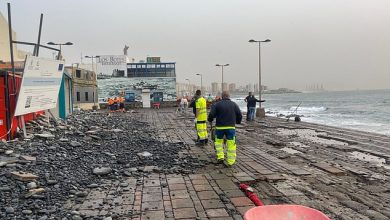What Saved Lives in the Baltimore Bridge Collapse

- Certain factors may have minimized the loss of life in the Baltimore bridge collapse.
- Police quickly stopped traffic, the collision occurred overnight and rescue efforts were intense.
- Some things appear to have gone well, maritime experts told BI.
Two people were killed and four are missing and presumed dead after a collision with a cargo ship caused the shocking collapse of Baltimore’s Francis Scott Key Bridge — and authorities and maritime experts say it could have been much worse .
But lives were saved thanks to a number of things that fell into place early Tuesday morning: quick thinking by the ship’s crew and Port Authority police, an emergency communications system that seems to have worked as expected and very lucky.
The distress call was a key factor, maritime experts told Business Insider.
The crew of the Singapore-marked container ship Dali issued a distress message after apparently losing propulsion, giving authorities controlling the bridge a critical period of about 90 seconds to prevent more vehicles from crossing the span.
Radio recordings reveal just how little time the Baltimore Port Authority police had.
At 1:27 a.m., a police officer is heard ordering other police officers to stop traffic.
“I need one of you guys on the south side and one of you guys on the north side. Hold all traffic on the Key Bridge,” the officer said. “There is a ship approaching that has just lost its direction.”
Police block the entrance to the Francis Scott Key Bridge in Baltimore, Maryland on March 29, 2024. Scott Olson; Getty Images
As police confirmed the orders, the officer also asked to contact the foreman of a work crew on the bridge and have her come down “immediately.”
But a few seconds later, the bridge collapses. Rescue teams spent Tuesday and Wednesday searching the frigid Patapsco River for survivors.
On Wednesday, authorities announced they found the bodies of two people inside a submerged pickup truck. Four other men are still missing.
In seconds, authorities saved lives
Kevin Battle, the port captain of Portland, Maine, told BI he was “amazed” that police were able to stop traffic toward the bridge as quickly as they did.
“What happened is horrible, but it could have been worse: we don’t know how many lives were saved thanks to their quick responses,” he said.
The Mayday would have alerted all traffic around the 984-foot vessel that it was in trouble. That call likely would have been followed by a description of the distress that was occurring, Eric Dawicki, president of the Northeast Maritime Institute, told Business Insider.
It was by sounding the alarm that those responsible for the bridge were informed, he said.
“When called, the officers at the bridge did an outstanding job stopping traffic at each end. And that’s what truly saved lives. They are truly the unsung heroes of this event,” said Dawicki.
Andy Middleton, director of the Apostleship of the Sea in Baltimore, a Catholic ministry for seafarers, told BI that he spent time with two members of the crew before they left for what was expected to be a 28-day trip, taking them to a nearby Walmart. Monday to purchase personal items.
He said his brief interactions with the crew — as well as his 15 years of helping sailors — lead Middleton to believe every effort was made to prevent what happened.
The crew dropped the ship’s anchor to try to avoid a collision with the bridge support, according to the Maritime and Port Authority of Singapore, where the ship was flagged.
“I can’t imagine that, under these circumstances, if they had the opportunity to save lives or minimize the damage, they wouldn’t have done it,” Middleton said. “The fact that there was a call for help would be consistent with what I believe to be the character of seafarers.”
Capt. James Staples, principal at consulting firm OceanRiverLLC, said the rescue call did not allow enough time to stop all cars from crossing the 1.6-mile-long bridge.
Still, this prevented many cars from going up. Issuing the distress call is an essential step that the pilot could have forgotten in the chaos, he said.
Rescuers pulled two people – and two bodies – from the freezing river after the Francis Scott Key Bridge collapsed. Kevin Dietsch/Getty Images
Beyond alerting authorities, Coast Guard search and rescue efforts were quick enough to pull two people from the water.
“They were immediately on scene and made sure they could be there to pick up the survivors,” Dawicki told BI. “They just did an outstanding job.”
Philip Schifflin, director of the Center for Mariner Advocacy at the Seaman’s Church Institute, told BI that the “robust” and “thorough” search and rescue efforts he had observed through media coverage suggested that anyone who may have could have been saved were.
“If there was someone living on the surface of the water, they probably would have been found and recovered,” he said.
Another mundane factor: timing.
The bridge was struck and collapsed early Tuesday morning, when there was little vehicle traffic on the span. Video of the incident shows cars passing the bridge seconds before the crash, and a local man drove across the bridge after an argument with his girlfriend moments earlier. The telegraph reported.
If the ship had collided with the bridge during the day or, even worse, during rush hour, the number of casualties would likely have been much higher.
Training and technology can help limit disasters
Crews train for loss of propulsion and steering, among other scenarios, Capt. Michael Campbell of the Massachusetts Maritime Academy told BI. He warned that it was too early to say what was wrong with the cargo ship called Dali. “I talked to marine engineers and other captains and everyone was speculating about what happened. And you can’t tell from the video,” he said.
The Dali also crashed into a European port in 2016.
Yet when a crisis arises, having learned how to respond can save lives, Campbell said. “The most important thing is that with practice – the more reps – it becomes second nature. It’s not, ‘OK, what do I do now?’ “, did he declare.
Campbell said many operators in the maritime industry perform quarterly checks for situations such as steering failure.
Ships heading to or leaving port must conduct systems tests within 12 hours of departure. This includes checking propulsion and steering systems as well as other electronic devices, maritime experts told BI.
Dawicki, of the Northeast Maritime Institute, said students at the college undergo extensive training – from first aid to emergencies they might expect at sea. It’s mandated in part by an international treaty for professional mariners , whether the ship is based in the United States or elsewhere.
Campbell also said that technology on board ships has improved significantly since he began his career in the 1980s. There are safety systems – often put in place or strengthened due to previous incidents – and technologies such as GPS and widespread automation that have improved the operation of ships, he said. “You’re not counting on someone going to turn a valve or anything like that,” Campbell said. “Things are better controlled.”
businessinsider




